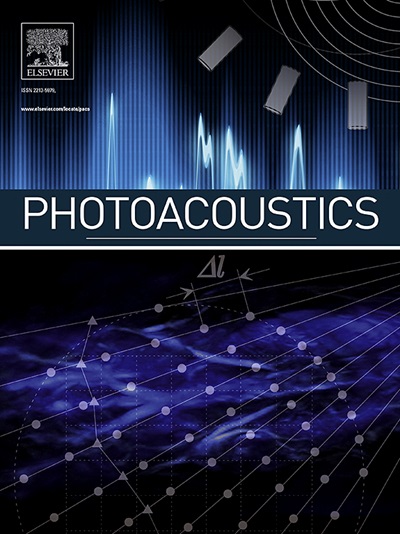Laser ultrasound wave pattern analysis for efficient defect detection in samples with curved surfaces
IF 6.8
1区 医学
Q1 ENGINEERING, BIOMEDICAL
引用次数: 0
Abstract
Many production processes involve curved sample surfaces, such as welding or additive manufacturing. These pose new challenges to characterization methods for quality inspection, which are usually optimized for flat extended sample geometries. In this paper, we present a laser ultrasound (LUS) method that can be used to efficiently detect defects (e.g., voids), without extensive scanning effort and without a prior knowledge of the defect location, in finite samples with curved surfaces. The developed method starts with generalized simulations of the LUS wave patterns in samples with varying radii of curvature and width as well as varying excitation size and mechanism (thermoelastic or ablative). Based on the wave pattern analysis, it is possible to predict how every point in the weld can be reached with only few excitation spots. In a second step, we assume a grid of finite size defects at locations at which such voids are most likely formed and perform a thorough simulation analysis that is based on B-Scans to find a few pairs of excitation–detection points most favorable for finding defects anywhere in the weld seam. These results are then compared to the wave pattern analysis, discussing similarities and deviations from the predictions. In a final step, the simulations are compared to experimental results, verifying the almost threefold increase in the detectability of defects by choosing the predicted optimal excitation–detection positions. It is expected that this method will significantly improve the reliability and time efficiency of detecting internal defects in samples with curved surfaces in potential industrial applications.
激光超声波波形分析用于高效检测具有曲面的样品中的缺陷
许多生产过程都涉及曲面样品,如焊接或增材制造。这给质量检测的表征方法带来了新的挑战,因为这些方法通常是针对平面扩展样品几何形状进行优化的。在本文中,我们介绍了一种激光超声(LUS)方法,该方法可用于在具有曲面的有限样品中有效检测缺陷(如空洞),无需大量扫描工作,也无需事先了解缺陷位置。所开发的方法首先对具有不同曲率半径和宽度以及不同激发尺寸和机制(热弹性或烧蚀)的样品中的 LUS 波形进行了通用模拟。根据波形分析,我们可以预测如何只用很少的激励点就能达到焊缝中的每一点。第二步,我们假定在最有可能形成空洞的位置存在有限尺寸的缺陷网格,并根据 B-Scan 进行彻底的模拟分析,以找到最有利于在焊缝任何位置发现缺陷的几对激振检测点。然后将这些结果与波形分析进行比较,讨论与预测结果的相似性和偏差。最后,将模拟结果与实验结果进行比较,验证通过选择预测的最佳激波检测位置,缺陷的可探测性几乎提高了三倍。预计在潜在的工业应用中,这种方法将大大提高检测曲面样品内部缺陷的可靠性和时间效率。
本文章由计算机程序翻译,如有差异,请以英文原文为准。
求助全文
约1分钟内获得全文
求助全文
来源期刊

Photoacoustics
Physics and Astronomy-Atomic and Molecular Physics, and Optics
CiteScore
11.40
自引率
16.50%
发文量
96
审稿时长
53 days
期刊介绍:
The open access Photoacoustics journal (PACS) aims to publish original research and review contributions in the field of photoacoustics-optoacoustics-thermoacoustics. This field utilizes acoustical and ultrasonic phenomena excited by electromagnetic radiation for the detection, visualization, and characterization of various materials and biological tissues, including living organisms.
Recent advancements in laser technologies, ultrasound detection approaches, inverse theory, and fast reconstruction algorithms have greatly supported the rapid progress in this field. The unique contrast provided by molecular absorption in photoacoustic-optoacoustic-thermoacoustic methods has allowed for addressing unmet biological and medical needs such as pre-clinical research, clinical imaging of vasculature, tissue and disease physiology, drug efficacy, surgery guidance, and therapy monitoring.
Applications of this field encompass a wide range of medical imaging and sensing applications, including cancer, vascular diseases, brain neurophysiology, ophthalmology, and diabetes. Moreover, photoacoustics-optoacoustics-thermoacoustics is a multidisciplinary field, with contributions from chemistry and nanotechnology, where novel materials such as biodegradable nanoparticles, organic dyes, targeted agents, theranostic probes, and genetically expressed markers are being actively developed.
These advanced materials have significantly improved the signal-to-noise ratio and tissue contrast in photoacoustic methods.
 求助内容:
求助内容: 应助结果提醒方式:
应助结果提醒方式:


